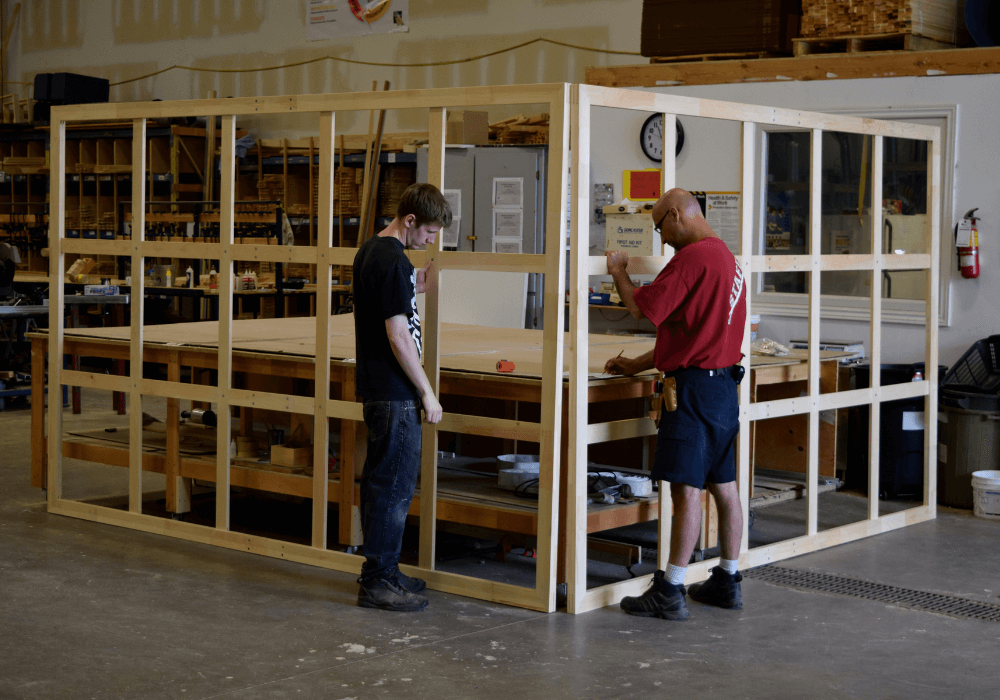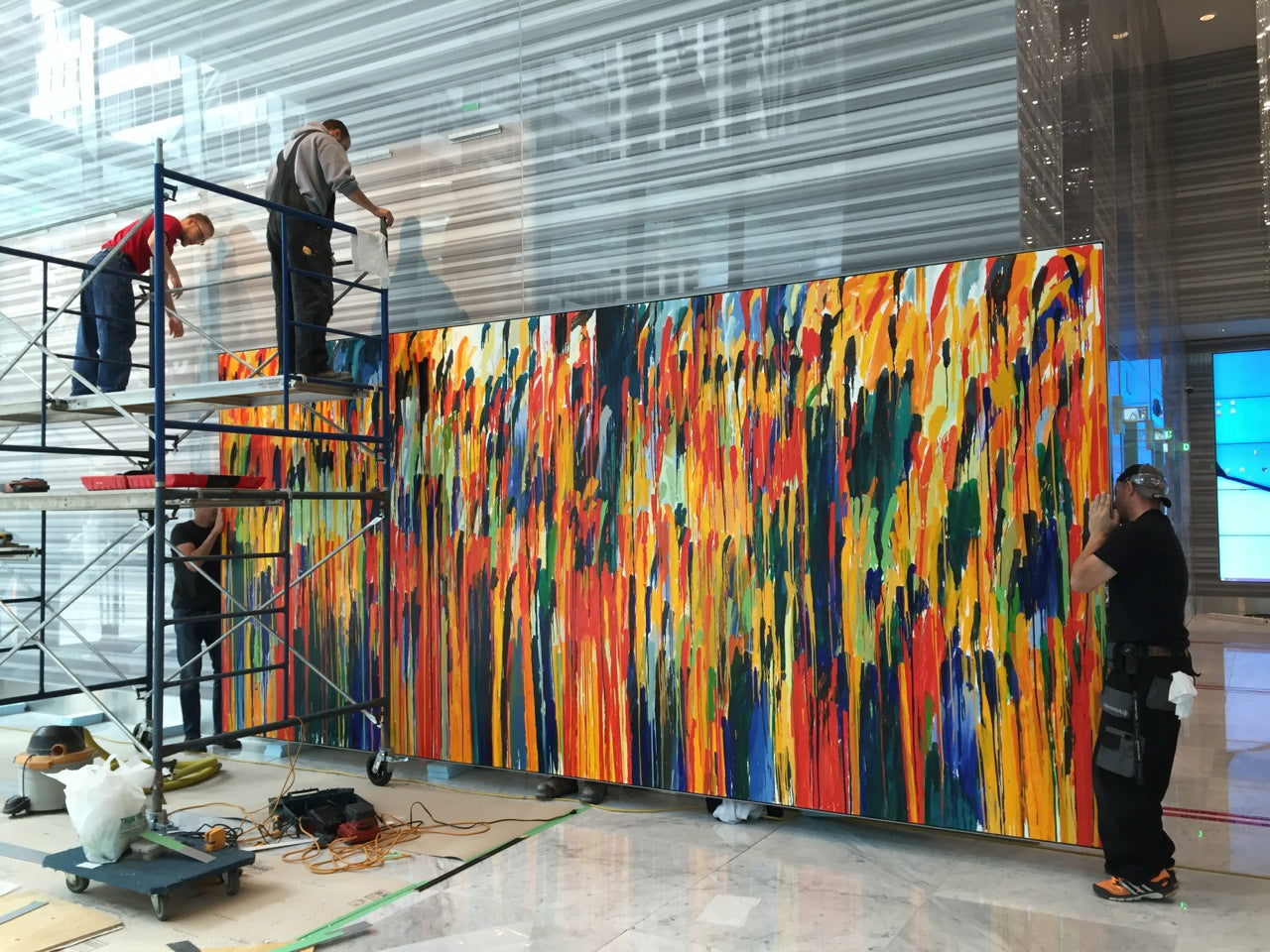
It’s critically important that your canvas frame has perfectly square corners adjoining straight, true stretcher bars… most of the time.
But what if your project is a little outside of that box? An artist’s vision isn’t always contained within the confines of four straight lines. In fact, some aren’t just painting outside the lines–they’re moving the lines entirely with round, oval, arched and even 3D canvas frames.
In this post, we’ll learn more about what goes into making an irregularly shaped frame, and explore stunning examples of unusually shaped canvases to perhaps inspire a project of your own!
WHAT DIFFERENT SHAPES DO CANVAS STRETCHERS COME IN?
Custom frames can come in any size and shape you desire, from geometric shapes like triangles and ovals to irregular designs you’ve dreamed up. Over the years we’ve created round and shaped stretchers over 19 feet in diameter!
 A custom 19-foot round canvas frame goes through quality checks in the Upper Canada Stretchers workshop.
A custom 19-foot round canvas frame goes through quality checks in the Upper Canada Stretchers workshop.
Of course, the larger the frame, the greater the demands for support. Rounded frames this large are achieved by first precision-cutting plywood strips using our CNC machine, then laminating them together for maximum strength. Cross-bracing adds support, and gravity bars are recommended for hanging.
Learn More About Irregularly Shaped Stretchers
CNC machining also enables us to create arched and other irregularly shaped canvas frames, like these ones for artist, Landon Metz.



These arched and irregular stretcher frames were designed and machined in Owen Sound, then shipped to Denmark for assembly and mounting.
Custom design and machining means that shipping and assembly can also be taken into account; in this case, we used flush joint connector bolts to assemble the frame. That made for simple disassembly and reassembly–an important feature considering the frames were being transported from North America to Denmark!
ARE IRREGULARLY-SHAPED CANVAS FRAMES WEAKER THAN SQUARE OR RECTANGULAR FRAMES?
Not anymore. You can imagine the challenges of creating a rounded frame in decades past when woodworking techniques like steaming or cutting and glueing to bend wood resulted in beautifully arched pieces. The problem is, those techniques were typically used to bend wood that would then be supported by other structure; the pieces were used as decorative trim, or countertop edging.

 Elora artist Joel Masewich’s ‘Road Less Travelled,’ canvas over UCS-made CNC panels with stainless steel and acrylic, 54 x 192 inches. Photo: JoelMasewich.com.
Elora artist Joel Masewich’s ‘Road Less Travelled,’ canvas over UCS-made CNC panels with stainless steel and acrylic, 54 x 192 inches. Photo: JoelMasewich.com.
Your canvas frame has to be able to stand on its own, so to speak - to support the weight of your canvas and keep it tight, to prevent damage to your piece. Today, the combination of modern machining and proven design principles enable us to create beautiful atypically shaped frames with all of the strength and durability of their square counterparts.
In fact, our rounded and arched frames can be made keyable, so you can adjust the tension of your canvas over time, just as you would with any other frame. (Not sure whether you need a keyable canvas? See this post on what keyable means and why it matters.)

Above is a keyable shaped stretcher frame design and below, a fixed strainer frame which is not keyable.
 Look for a design that has a raised edge to keep your canvas from rubbing against the wood on your rounded frame.
Look for a design that has a raised edge to keep your canvas from rubbing against the wood on your rounded frame.
One other important design feature you want to see is a raised edge, a front "fall" or slope, on your irregularly-shaped frame. This reduces the canvas's contact with the frame except at the very edge, preventing "ghosting" marks if the canvas were to touch the inside edge of the frame as you are pushing on the canvas while painting. Having too much contact with the wood underneath can also wear at the canvas over time.
EXPERT TIPS FOR STRETCHING CANVAS ON IRREGULARLY-SHAPED FRAMES


Superior design and careful machining ensure that even your irregularly-shaped canvases will remain a strong, durable support for your best works throughout their lifetime.
- When stretching canvas onto a round or other shaped frame, always start with unprimed cotton or linen canvas over the frame first, then prime it. Unprimed canvas is more flexible, helping prevent unsightly folds or pleating in the canvas when you’re stretching over a round, oval, or arched frame. The thicker your frame, the more difficult it is to prevent canvas folds (and the more important it becomes to work with unprimed canvas).
- Choose carefully between cotton and linen canvas for your irregularly-shaped project. How comfortable are you stretching your own canvas? How large is the piece? What’s your budget? Learn more about the differences between cotton and linen for different types of projects in this post.
- Where will your piece hang? How far is it being shipped? Will you need to move the piece often, and do you need a keyable stretcher frame? It’s helpful for the team designing your irregularly-shaped frame to understand how factors like the type of canvas and paint you plan to use, humidity levels and temperatures in the area the piece will be displayed in, (and more) might affect the materials and techniques required to make the best frame for your unique needs. Talk with a custom frames expert to see exactly what you need to bring your vision to life.
WANT TO LEARN MORE?
- See more photos of irregularly shaped frames here.
- Explore the advanced stretcher bar design features that support your largest works.
- Get a free, no obligation quote for your irregularly shaped custom frame.
Learn More About Irregularly Shaped Stretchers








